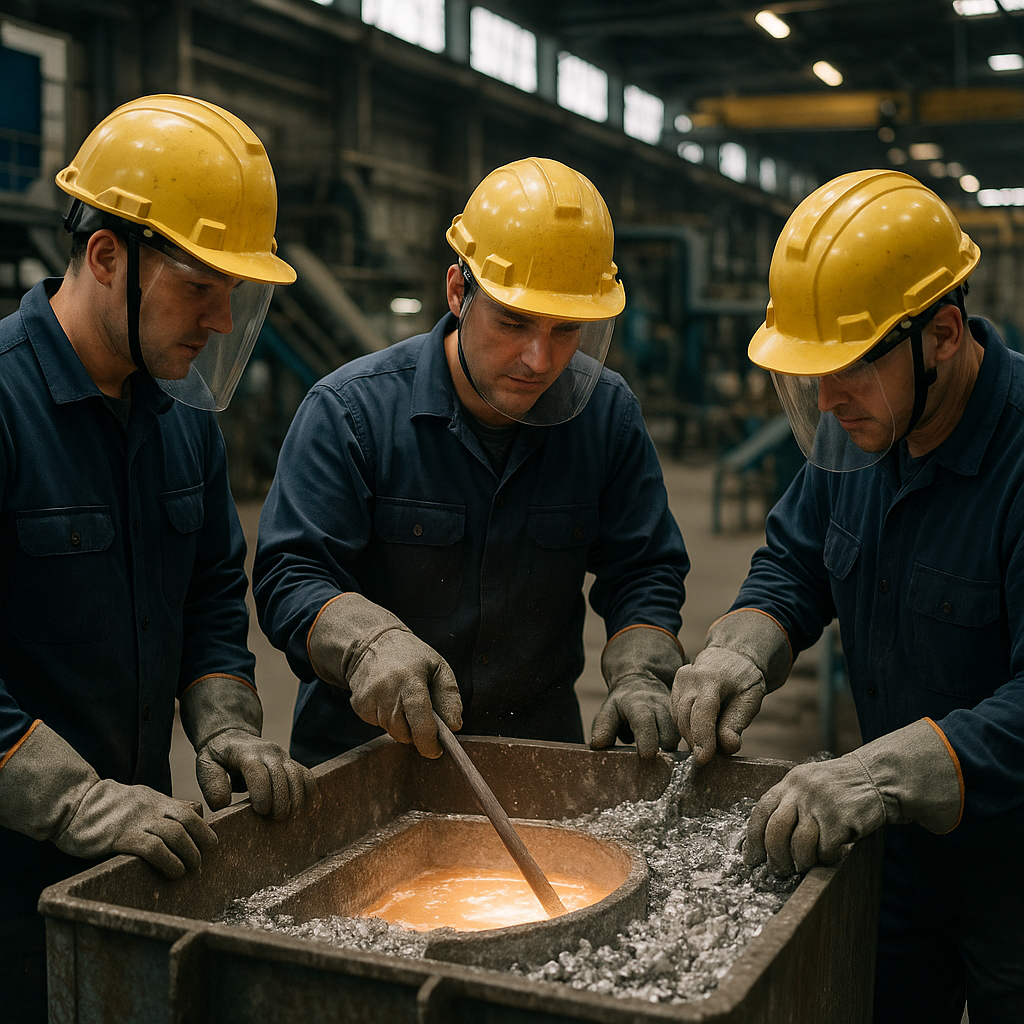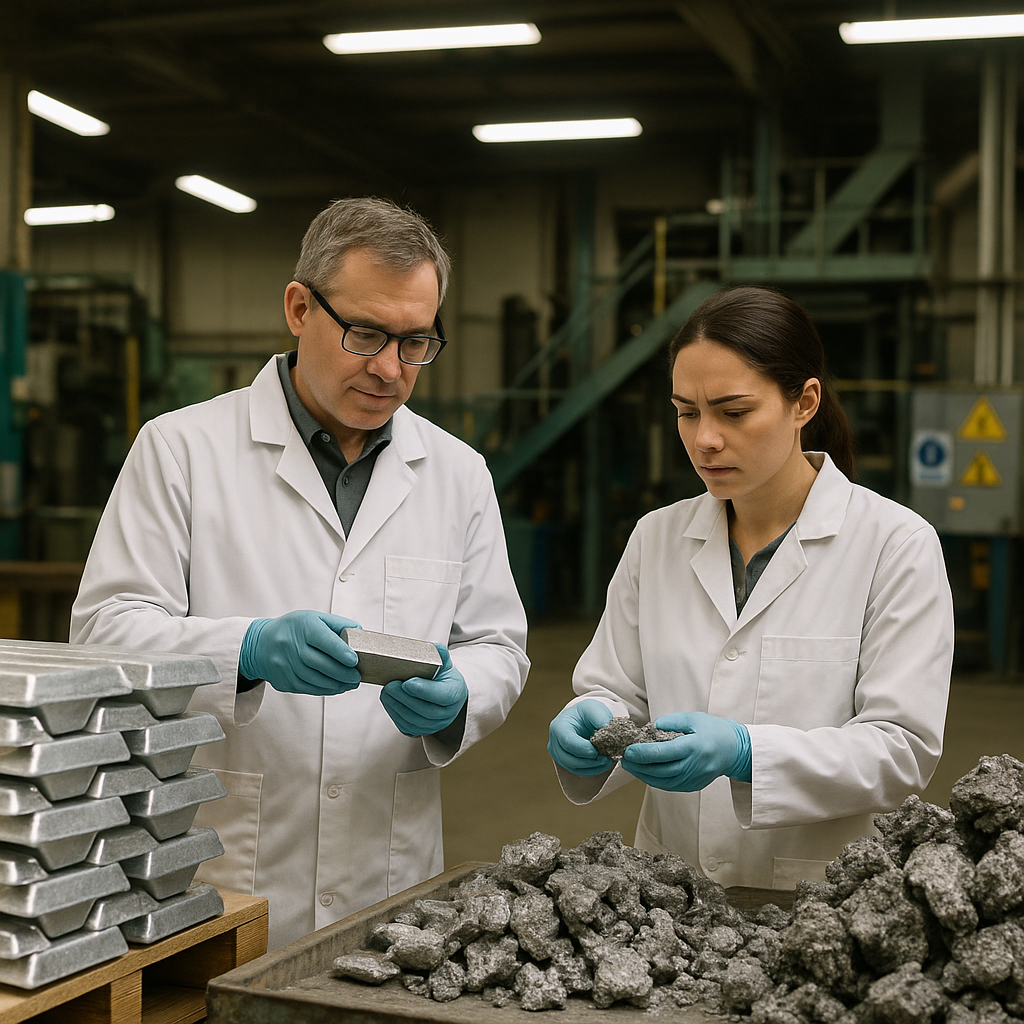5901 Botham Jean Blvd, Dallas, TX 75215
Aluminum Dross Recycling: Processes, Benefits, and Future Innovations
October 9, 2025Aluminum dross is a byproduct that forms during aluminum smelting and recycling operations. When aluminum is melted in furnaces, the surface of the molten metal reacts with oxygen in the air, creating a layer of aluminum oxide. This reaction forms a semi-solid, foam-like material that floats on top of the liquid aluminum. The resulting dross is a complex mixture typically containing between 15-80% recoverable aluminum metal trapped within an aluminum oxide matrix.
The formation process begins when aluminum scrap or raw materials are heated to temperatures between 700-750°C in melting furnaces.
As the metal melts, the exposed surface begins to oxidize immediately. Mechanical operations like stirring and skimming further mix the oxide layer with the underlying metal. The cellular structure of dross is remarkably strong, capable of mechanically binding aluminum at up to twenty times its weight.
How is Aluminum Dross Processed and Recycled?

Processing aluminum dross is crucial for recovering valuable metals and materials from potential industrial waste. The industry uses several methods to process dross effectively, chosen based on its composition and the desired end products. Here’s a closer look at these processing techniques.
Pyrometallurgical Processing Methods
Hot dross processing is a common pyrometallurgical approach. This method efficiently recovers metallic aluminum without chemically reducing aluminum oxides. The process involves:
- Crushing and Ball Milling – Dross is crushed to break down the material into smaller, manageable particles.
- Screening and Separation – The crushed material is screened and separated based on density, forming aluminum-rich and aluminum oxide-rich particles.
- Metal Recovery – Aluminum-rich particles are melted in a furnace to remove remaining oxide particles, recovering aluminum metal.
- Processing Residues – The non-metallic fraction can be further processed for additional applications.
This mechanical process avoids the toxic chemicals used in older extraction methods, making it more environmentally friendly.
Hydrometallurgical Processing Methods
Chemical processing techniques offer alternative approaches for dross treatment, especially useful for dross with lower metallic aluminum content:
- Alkali Dissolution – Aluminum dross reacts with sodium hydroxide (NaOH) solution to dissolve aluminum components. Optimal conditions typically include:
- Reaction temperature around 50°C
- Reaction time of approximately 60 minutes
- NaOH concentration of about 3 molar
- Acid Leaching – Utilizing acids (often H2SO4), this technique extracts aluminum from dross through:
- Controlling pH levels to separate impurities
- Selective precipitation of aluminum compounds
- Filtration to collect aluminum-rich products
These methods can achieve aluminum recovery rates between 45-85%, depending on dross composition and processing conditions.
Combined Processing Approaches
Modern facilities often use a combination of pyrometallurgical and hydrometallurgical methods to maximize recovery and product quality:
- Initial Physical Separation – Dross is processed through ball milling and screening to recover coarse aluminum particles.
- Secondary Chemical Processing – The remaining material undergoes chemical treatment to extract additional aluminum compounds.
- High-Value Product Formation – Extracted materials are then processed into valuable products like calcium aluminate, aluminum hydroxide, or alumina.
This integrated approach helps achieve nearly complete utilization of dross material while minimizing environmental impact.
Factors Affecting Processing Method Selection
Several key factors determine the most suitable processing method for aluminum dross:
- Dross Composition – Content of metallic aluminum, oxides, and other compounds
- Economic Considerations – Processing costs versus value of recovered materials
- Environmental Regulations – Local requirements for waste processing and disposal
- Desired End Products – Whether the goal is pure aluminum recovery or the production of aluminum compounds
Successful dross processing facilities analyze these factors to implement the most efficient recycling strategy for their specific circumstances.
Recycling aluminum dross not only recovers valuable materials but also prevents environmental contamination that could occur if this industrial byproduct were landfilled. Modern processing technologies continue to improve, making aluminum dross recycling increasingly economical and environmentally sustainable.
What are the Benefits and Challenges of Dross Recycling?

Aluminum dross recycling is crucial for sustainable metal management, offering substantial environmental and economic benefits when correctly executed. However, there are several technical and logistical challenges to address for optimal effectiveness.
Benefits of Aluminum Dross Recycling
- Resource Conservation: Recycling preserves bauxite reserves, the primary ore for aluminum production. Every ton of aluminum recovered from dross saves about four tons of bauxite mining.
- Energy Efficiency: Recovering aluminum from dross uses only 5% of the energy required to produce primary aluminum from bauxite, leading to approximately 95% energy savings and a smaller carbon footprint.
- Landfill Reduction: Proper recycling diverts substantial waste from landfills. Without it, millions of tons of dross would need disposal annually, consuming landfill space and posing leaching risks.
- Pollution Prevention: Untreated aluminum dross can react with water to produce harmful gases. Recycling prevents these emissions and reduces fluoride releases linked to primary production.
- Economic Value: Recovered aluminum retains quality through infinite recycling, creating ongoing value from what would otherwise be waste.
- Job Creation: The dross recycling industry generates jobs across collection, processing, and manufacturing sectors.
Challenges of Aluminum Dross Recycling
- Hazardous Material Management: Certain dross types, especially black dross with high salt content, contain hazardous compounds requiring specialized handling and equipment.
- Variable Composition: Dross composition varies based on source and processing history, complicating standardized processing and often necessitating customized solutions.
- Salt Content Management: High salt levels, notably in black dross, complicate processing and pose environmental risks if not properly managed. Salt leaching can contaminate soil and groundwater if disposed of improperly.
- Recovery Rate Optimization: Maintaining cost-effective, high recovery rates is challenging. Current technologies recover between 30-75% of aluminum from dross, depending on the dross type and processing method.
- Energy Requirements: Although more efficient than primary production, some processing methods still require significant energy, particularly high-temperature pyrometallurgical approaches.
- Technical Complexity: Effective recycling often involves sophisticated separation technologies that require specialized knowledge and equipment.
The aluminum industry is developing new methods to overcome these challenges, including improved mechanical separation technologies, advanced thermal processing, and innovative hydrometallurgical methods. Research focuses on enhancing recovery rates and minimizing environmental impacts through salt management systems and efficient processing technologies.
Ultimately, effective dross management involves balancing recovery efficiency with environmental protection. When implemented correctly, aluminum dross recycling offers a sustainable approach to managing this industrial byproduct, recovering valuable materials, and protecting the environment.
As environmental regulations tighten and sustainability demands grow, developing efficient dross recycling systems is becoming an essential priority for the aluminum industry.
Future Trends in Aluminum Dross Processing

The aluminum recycling industry continues to make significant strides in addressing one of its most challenging byproducts: aluminum dross. Emerging technologies are transforming what was once considered waste into a valuable resource. Innovative separation methods using nanofiltration technology now enable recovery of over 99% of aluminum ions from dross, dramatically improving resource efficiency and reducing environmental impact.
Advanced molten salt electrolysis represents another breakthrough in dross processing. This technology allows for the recovery of high-purity aluminum from complex dross compositions that traditional methods cannot effectively process. The resulting recycled aluminum is comparable in quality to primary production but requires only a fraction of the energy and has a smaller environmental footprint.
The construction industry is pioneering new uses for processed dross residues. Research shows that incorporating treated aluminum dross into concrete can enhance its strength and durability while reducing the need for virgin materials. This creates a circular economy solution, where waste from one industry becomes a valuable input for another.
Final Words
Looking ahead, efforts are focusing on preventing dross formation from the outset. Electromagnetic stirring technologies in furnaces have proven effective at reducing dross generation by up to 15% while simultaneously increasing productivity and lowering energy consumption. These preventative approaches, combined with more efficient recovery methods, point toward a future where aluminum recycling achieves near-zero waste.
The journey toward sustainable aluminum recycling continues to evolve through collaboration between research institutions, technology providers, and industry partners. For businesses seeking environmentally responsible recycling solutions that maximize resource recovery, contact Okon Recycling at 214-717-4083.
